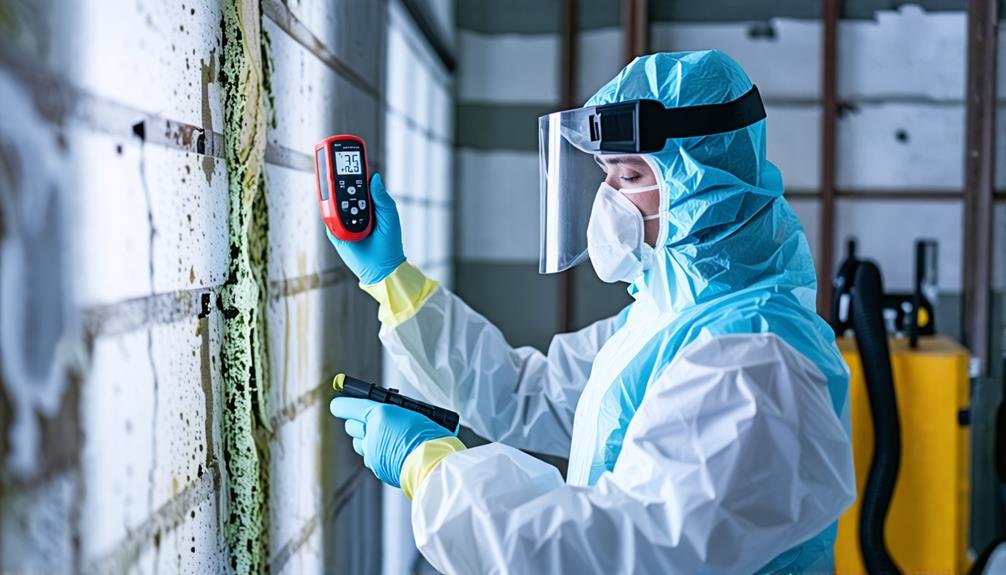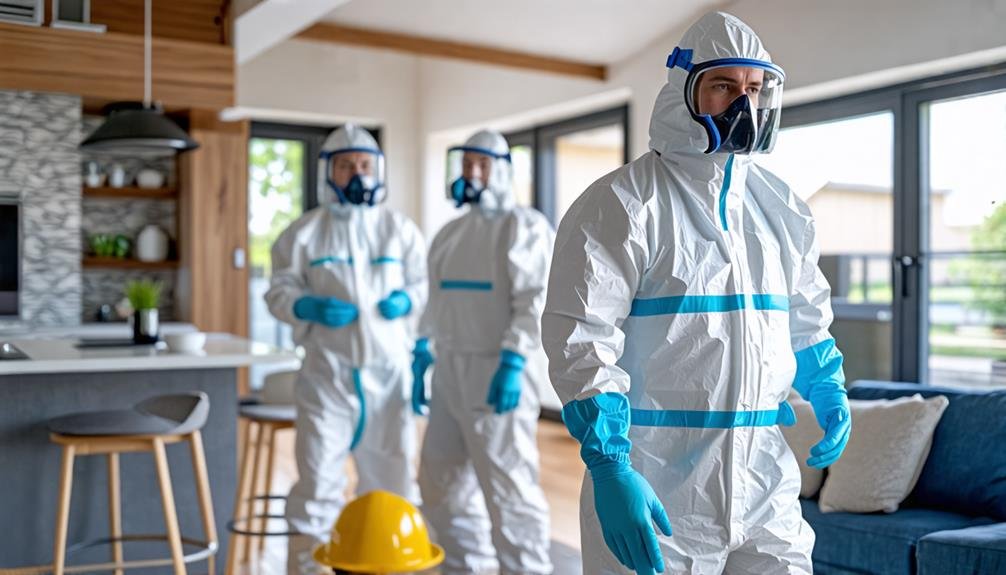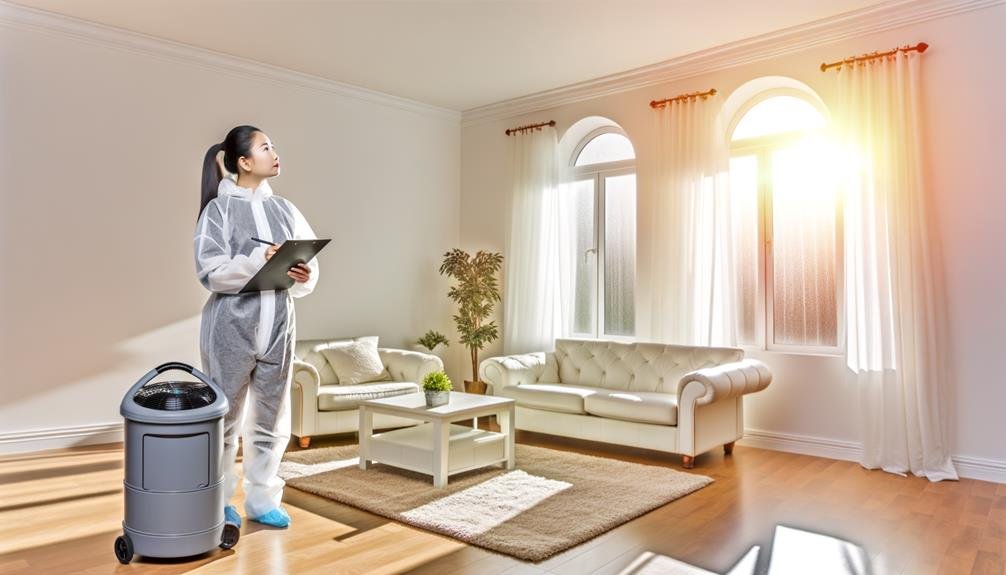If you're in Union City and facing mold issues, addressing them is vital for your health and home. Mold thrives in damp conditions and presents serious risks, including respiratory problems. You'll recognize infestations by visible mold growth, musty odors, and water damage signs. The remediation process involves evaluating the problem, safely removing contaminated materials, and preventing future growth through humidity control and proper ventilation. While DIY methods can help, professional services guarantee thorough removal and testing for peace of mind. Understanding these key aspects will equip you to maintain a safer, cleaner living environment, enhancing your home's overall health.
Understanding Mold and Its Risks

Mold is a type of fungus that thrives in damp environments and can pose serious health risks if left untreated. You should be aware that various mold types, such as Aspergillus, Cladosporium, and Stachybotrys (commonly known as black mold), can affect your indoor air quality. Each type has its unique characteristics and potential dangers.
The mold health effects can range from mild allergic reactions to severe respiratory issues. Exposure may cause symptoms like sneezing, coughing, and skin irritation. In more vulnerable populations, such as children, the elderly, or individuals with pre-existing health conditions, the risks are even higher. Prolonged exposure to certain mold types can lead to chronic respiratory diseases, neurological problems, or even immunosuppression.
Understanding the specific mold types present in your environment is essential for evaluating their potential health risks. You can empower yourself by learning how to identify these molds and their associated health effects. This knowledge not only helps you take appropriate measures for your well-being but additionally promotes a safer living space. Don't underestimate the importance of addressing mold issues promptly and effectively.
Signs of Mold Infestation
When evaluating your property for mold infestation, look for visible mold growth, which can appear as patches or spots in various colors. You should likewise be aware of any musty odors, as these often indicate hidden mold. Furthermore, check for signs of water damage, such as stains or peeling paint, which can create ideal conditions for mold development.
Visible Mold Growth
Spotting visible mold growth is vital for identifying a potential infestation in your home. Mold can appear in various forms, with different mold types presenting unique colors and textures. The most common visible molds include greenish-black mold, fuzzy white mold, and yellowish mold. These can thrive in damp, humid areas, and ignoring them can lead to health effects ranging from respiratory problems to skin irritations.
To guarantee your home remains safe, look for these signs:
- Discoloration: Look for patches of different colors on walls, ceilings, or floors.
- Surface texture changes: Notice if surfaces feel slimy or fuzzy, indicating mold growth.
Being proactive about spotting visible mold growth not only protects your home but likewise preserves your health. If you find any signs, addressing them promptly is vital. Taking action against mold infestation can help you maintain a clean, safe living environment, making sure that you and your loved ones enjoy freedom from the adverse effects of mold exposure.
Musty Odors Present
A musty odor in your home often signals hidden moisture and potential mold growth lurking in areas that aren't immediately visible. These musty smells can originate from various odor sources, including damp basements, poorly ventilated bathrooms, or leaks behind walls. Mold thrives in environments where humidity levels exceed 60%, making it vital to identify and address these odors promptly.
When you notice a musty smell, start by investigating the areas where moisture is likely to accumulate. Check for condensation on windows, water stains, or any signs of dampness. If the smell persists, it may be time to inspect hidden spaces such as crawl spaces, attics, or behind appliances.
Ignoring musty odors can lead to more severe mold problems, which can affect your health and the structural integrity of your home. It's critical to act swiftly. Consider using a moisture meter to assess humidity levels and pinpoint possible sources of moisture. Once identified, addressing these issues can help restore a clean, healthy environment and eliminate those unpleasant odors for good. Remember, early detection is key to effective mold remediation.
Water Damage Indicators
Identifying water damage indicators is essential, as they often signal a mold infestation waiting to take hold in your home. Understanding these signs can empower you to take action and protect your living space from potential threats. Keep an eye out for the following indicators:
- Discoloration on walls or ceilings: Yellow, brown, or dark spots often indicate water damage from leaks or high humidity levels.
- Peeling or bubbling paint: This can suggest trapped moisture beneath the surface, a perfect environment for mold to thrive.
Regularly inspecting areas prone to water damage—such as bathrooms, basements, and around windows—can help you catch problems early. Additionally, addressing any water sources and maintaining ideal humidity levels in your home will drastically reduce the chances of mold developing. Stay vigilant, and remember, your proactive measures can guarantee a clean, safe living environment free from mold hazards.
The Mold Remediation Process

The mold remediation process begins with a thorough assessment and inspection of your property to identify the extent of the infestation. Once you understand the situation, effective removal and prevention techniques are implemented to guarantee the mold doesn't return. This systematic approach is vital for restoring a safe environment in your home.
Assessment and Inspection
During the assessment and inspection phase of mold remediation, professionals thoroughly evaluate the affected areas to determine the extent of contamination and identify moisture sources. This pivotal step guarantees that you understand the severity of the mold issue and its potential impact on your indoor air quality.
They typically employ various mold testing methods, such as air sampling and surface testing, to accurately gauge the presence of mold spores. Understanding these methods allows you to make educated choices about the remediation process and how it will affect your living environment.
Here are key aspects of the assessment phase:
- Visual Inspection: Inspectors look for visible mold growth and water damage, highlighting problem areas.
- Moisture Measurement: Using hygrometers or moisture meters, they assess humidity levels and pinpoint moisture sources.
With a thorough assessment, you can take the necessary steps to reclaim your home, guaranteeing a safe and healthy environment for you and your family.
Removal and Prevention Techniques
Effective mold remediation involves a systematic approach to removing existing mold and preventing future growth through targeted techniques. First, make sure you wear appropriate personal protective equipment (PPE) such as gloves, masks, and goggles before beginning mold removal. Contain the area to prevent spores from spreading; seal off doorways and vents with plastic sheeting.
Next, identify and address moisture sources, as mold thrives in damp environments. Use dehumidifiers and fix leaks promptly to reduce humidity levels. For mold removal, scrub surfaces with a mixture of water and detergent or a specialized mold killer. Porous materials like drywall may need replacement if heavily infested.
Once you've completed the mold removal process, focus on mold prevention. Regularly inspect areas prone to moisture, like basements and bathrooms. Make sure proper ventilation in these spaces, and consider installing exhaust fans. You might as well apply mold-resistant products during renovations to inhibit future growth.
DIY Mold Removal Tips
To tackle mold in your home, start by wearing protective gear like gloves and a mask to guarantee your safety during the removal process. Once you're equipped, you can effectively address the issue using both natural remedies and effective cleaners.
Here are some DIY tips to help you:
- Vinegar Solution: Spray undiluted white vinegar on the affected areas. Its acidity kills most mold species without harsh chemicals.
- Baking Soda Paste: Mix baking soda with water to create a paste. Apply it to moldy surfaces, scrub lightly, and rinse with water. This method is safe and effective.
Benefits of Professional Services

Hiring professional mold remediation services not only guarantees thorough removal but similarly addresses underlying moisture issues to prevent future growth. When you choose experts, you're leveraging their professional expertise to identify mold types and assess the extent of the infestation. This is vital since different molds can have varying health impacts, including respiratory problems, skin irritations, and allergic reactions.
Professionals use advanced techniques and equipment that eliminate mold effectively, ensuring it doesn't return. They additionally conduct air quality tests to measure the level of mold spores in your home, providing you with peace of mind regarding your living environment.
Furthermore, certified mold remediation professionals adhere to safety protocols that protect you and your family from exposure during the cleanup process. Their systematic approach not only resolves the current issue but also mitigates risks associated with mold-related health problems.
Preventing Future Mold Growth
Preventing future mold growth requires a proactive approach to managing moisture levels and maintaining a clean environment in your home. By implementing effective strategies, you can greatly reduce the likelihood of mold recurrence. Start by investing in mold resistant materials for areas prone to dampness, such as bathrooms and basements. These materials not only resist mold growth but additionally contribute to a healthier living space.
To further improve your mold prevention efforts, consider the following:
- Humidity Control: Keep indoor humidity levels below 60%. Utilize dehumidifiers in areas with high moisture.
- Regular Cleaning: Clean bathrooms and kitchens frequently to eliminate mold spores and prevent buildup.
Conclusion
By addressing mold promptly, you're not just preserving your home; you're safeguarding your health and peace of mind. Think of mold as an uninvited guest, one that overstays its welcome and wreaks havoc if left unchecked. Adopt the proper remediation techniques, whether through DIY efforts or professional help, to restore your sanctuary. Remember, a mold-free home isn't just a dream; it's within your reach. Stay vigilant, and keep your living space safe and clean for years to come.

